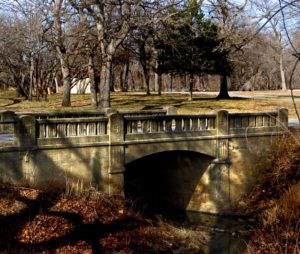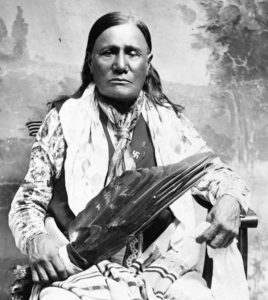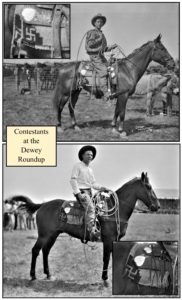Written by Debbie Neece of the Bartlesville Area History Museum and published in the October 2021 edition of bmonthly magazine.


As the result of a park bond election on August 31, 1915, the City of Bartlesville was able to purchase parkland from the families of early Bartlesville pioneers on January 13, 1916. Lucy Armstrong whose father was Arthur Armstrong, sold 16 acres; Nellie Johnstone Cannon whose father was William Johnstone, sold 40 acres; and Joseph Bartles whose father was Jacob Bartles, recognized as the founder of Bartlesville and Dewey, gifted additional land towards the park effort.
Johnstone Park has been a community staple hosting a varied list of events including picnic socials, seasonal festivities and religious services resulting in Caney River baptisms. The meandering drive following the west bank of the Caney River is lush with walnut trees and scurrying squirrels. Entering Johnstone Park, you are greeted by a childhood favorite…the Kiddie Park, followed by the Landmark Preservation Council’s refurbished Hulah Depot, the Burbank Oil Fire Fighting Cannon, Oklahoma’s First Commercial Oil Well…the Nellie Johnstone and then cross the swastika embellished bridge to reach the north loop of the park.
Understandably, the swastika creates a broad range of emotional responses; so, perhaps a brief history lesson will ease your concerns.
Osage Nation Minerals Council Chairman, Everett Waller says, “There was much Native American influence in embellishing the Johnstone Park Bridge with the swastika and the symbol of good luck for centuries is covered by symbols of water blessings and prayers.”
Originally, the northern part of Johnstone Park was only reachable by a rustic wooden pedestrian bridge. Then in 1917, Park Superintendent William Trautman built a wooden wagon bridge for better picnic area access. As park improvements were made, the dirt park roads were paved and the wagon bridge was replaced with a Dewey Portland Cement bridge in 1920.
Details of the decorative embellishments have eluded history books and area newspapers. However, Ernest Dewar Kirkpatrick was the City Engineer from 1911-1925 and his March 1920 drawings detail the specifications for the auto traffic bridge requiring 94 cubic yards of Portland cement with sixteen Native American good luck swastikas and water blessing symbols deeply recessed.
The Dewey Portland Cement Company was well versed in creating concrete molds as H.V. Foster had concrete quail, Don Tyler had a molded bull and the Dewey Portland Company logo was imprinted in cement.
One of the earliest historical appearances of the swastika symbol was at the ruins of Troy in the fourteenth century, B.C. Then, German archaeologist Heinrich Schliemann found swastikas during his archaeological excavation in 1870. Swastika symbols have been found in China, India, Greece, Israel and literally around the world, and remain widely used in Indian religions like Hinduism, Buddhism and Jainism as a symbol of divinity and spirituality.
Fast forward several centuries and the swastika or “Whirling Log of Life” became a deeply rooted symbol of good luck, good fortune, well-being and welfare for many Native American tribes.


Across the globe the swastika has been found carved upon rocks in the mountains of India and painted upon canyon walls in Arizona. In 1909, Osage Chief Peter Bigheart wore a swastika lapel pin as part of his traditional clothing. The symbol has been seen on American Indian blankets and pottery, in books, beadwork, basketry and artwork. In addition, Dewey Roundup (1908-1949) contestants had the indigenous symbol woven into their Pendleton saddle blankets. In 1925, “Coca Cola used the swastika as a sales slogan, the Boy Scouts adopted the symbol, and the Girls’ Club of America called their magazine Swastika and sent swastika tokens to young readers as prizes for selling copies of the magazine.”
Established in 1923, the 45th Infantry Division was a unit of the National Guard comprised of over 5,000 men from Arizona, Colorado, New Mexico and Oklahoma. Due to the large population of indigenous people living within the four representative states, an exceptionally large percentage of the National Guard’s 45th Infantry Division were of Cherokee, Choctaw, Seminole, Apache, Sioux, Kiowa, Pawnee, Comanche, Osage, Creek and Navajo decent. In honor of the strong Native American heritage held by the Guard members, their left shoulder insignia was a diamond shaped red patch with a yellow swastika in the center…a symbol reflective of their diverse cultures that celebrated a common theme…good luck.
That all ceased in the 1930s…President Franklin D. Roosevelt said, “This generation has a rendezvous with destiny.” No truer words have been spoken.
Germany’s National Socialist Party adopted the swastika as its symbol in 1920, tilting the symbol at a 45 degree angle, standing on its point, while the Native American swastika sits flat in optional left-right directions.

Once revered as the oldest cross in the world, the Nazi regime was able to bring a negative connotation to the once positive symbolism and it became forever tarnished. In 1939, the 45th Infantry Division retired the swastika from their uniforms and replaced it with a thunderbird, another Native American cultural symbol. The unit then became known as the “Thunderbirds.”
Evil has a way of worming its way into society and destroying centuries of peace and prosperity. Although the roots of the swastika were traditional and genuinely good, the symbol has been irreversibly desecrated by Nazi anti-Semitic ideology. By the 1940s, the swastika represented a symbol of fear, suppression, death and hate leading some American tribes to eliminate the use of the swastika symbol in their own expressive artwork. The multi-cultural symbol of good luck and positivity has been squashed by negativism and the propaganda of war resulting in a tragic cultural theft that reshaped world history.
We hope this history of the swastika has enlightened your world and given less power to the evil and more to your peace. May your next Johnstone Park visit bring you positive thoughts.
